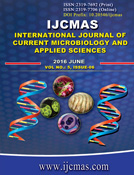


 National Academy of Agricultural Sciences (NAAS)
National Academy of Agricultural Sciences (NAAS)

|
PRINT ISSN : 2319-7692
Online ISSN : 2319-7706 Issues : 12 per year Publisher : Excellent Publishers Email : editorijcmas@gmail.com / submit@ijcmas.com Editor-in-chief: Dr.M.Prakash Index Copernicus ICV 2018: 95.39 NAAS RATING 2020: 5.38 |
Cowpea is rich in proteins and contains essential amino acids. It is used for nutrition. For the producers, it is an important source of incomes. Cowpea is mainly grown for its grains, its leaves, its young pods. However several viral diseases attack cowpea. The most dangerous one is yellow mosaic transmitted by aphids or Cowpea Aphid Borne Mosaic Virus (CABMV). This disease causes the decrease of crop at a rate of 60 to 90% and provokes dwarfism, chlorosis of nervures. The identification of polymorphic microsatellite markers linked to cowpea resistance to Cowpea Aphid Borne Mosaic Virus (CABMV) in Burkina Faso will allow to get resistant varieties to this disease. Extracting the genomic DNA of cowpea plants, their PCR amplification and the identification of polymorphic markers through the revelation of the PCR products have been carried out. Wenty seven (27) primers pairs having SSRs polymorphism test have allowed PCR amplification of the target DNA samples. The sizes of the different fragments ranged between 900 and 50 bases pairs (bp). The microsatellite polymorphism test was done with DNA extracted from six lines of cowpea KVx771-10 x IT93K693-2, ITN87-71-21 pl. 1-2, resistant to CABMV, Diébougou Local, KVx396-4-5-2D, moderately resistant to CABMV, KVx 61-1 and Gorom Local, very sensitive to CABMV. On a total of 27 markers, seventeen (17) markers revealed polymorphisms microsatellite loci between the six lines of cowpea, a polymorphism rate of 62.96 % obtained for these markers. The bands of the same size present in resistant and susceptible varieties could correspond to alleles of the gene conferring susceptibility to CABMV and those of same size present only in resistant varieties would be alleles of the gene conferring resistance to CABMV. The identified polymorphic markers will be used for validation.
 |
 |
 |
 |
 |